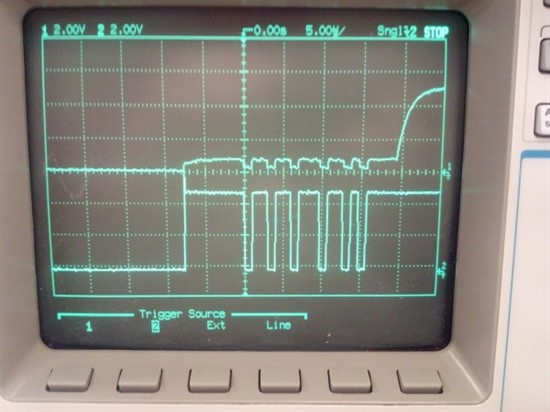Hello everyone,
I am currently attempting to program the DAC to work with the ATMega 128, I have a code library working and here is the basic code:
void UpdateDutyCycle(int dutyPercent)
{
// unsigned int dutyCycle;
// unsigned char byte0, byte1;
/* Ensure the Clock polarity is set to FALLING */
SPI_Set_Clock_Polarity(FALLING);
/* Ensure the Data order is set to MSB */
SPI_Set_Data_Order(MSB);
// unsigned int test = 65535;
DDS1_CS_HIGH; //Set the DDS CS to high
DDS2_CS_HIGH; // Set the DDS CS to high
VC_CS_HIGH; // Set the voltage control DAC CS to high
DC_CS_LOW; // Only enable to DAC associated with the duty cycle control to low to activate it
SPI_Transmit_Word(0b1011011011011010); // Transmit a 16-bit data
delay_us(2); // Wait a little bit
DC_CS_HIGH; // Set DAC CS high
}
Now for the code associated with the SPI_Transmit:
/***************************************************************
* SPI (Serial Peripheral Interface) Transmission Routine *
*--------------------------------------------------------------*
* Transmits a single byte (or byte array) of data using the *
* SPI bus. *
****************************************************************
* Inputs:----------------------------------------------------- *
* *cData - Pointer to the byte or byte array of data to be *
* transmitted. *
* length - Number of bytes to transmit *
***************************************************************/
void SPI_Transmit(unsigned char *cData, int length)
{
unsigned int index;
if (length > 0)
{
for (index = 0; index < length; index++)
{
/* Start transmission */
SPDR = *cData++;
/* Wait for transmission complete */
while(!(SPSR & (1<<SPIF)));
}
}
}
And the code for initilizing the SPI:
/***************************************************************
* SPI (Serial Peripheral Interface) Initialization Routine *
*--------------------------------------------------------------*
* Initializes the SPI communication bus with the specified *
* clock speed *
****************************************************************
* Inputs:----------------------------------------------------- *
* busSpeed - Specifies the SPI bus speed (expressed as a *
* division of the system clock speed of 16 MHz *
* Values: SPI_SPR_1x2, SPI_SPR_1x4, SPI_SPR_1x8 *
* SPI_SPR_1x16, SPI_SPR_1x32, SPI_SPR_1x64 *
* SPI_SPR_1x128 *
* dataOrder - Determines the order (LSB first or MSB first) *
* that data is transferred. *
* Values: LSB, MSB *
* polarity - Determines the clock polarity setting. *
* Values: RISING, FALLING *
***************************************************************/
void SPI_Initialize(unsigned char busSpeed, unsigned char dataOrder, unsigned char polarity)
{
/* Set MOSI (Master Out, Slave In) and SCK (Serial Clock) pins
to outputs, leave all the other pins in their current state */
DDRB |= (1 << MOSI) | (1 << SCK);
/* Set the Double SPI Speed Bit */
SPSR = (busSpeed >> 2);
/* Set the Data order bit */
if (dataOrder == LSB)
SPCR |= (1 << DORD);
else
SPCR &= ~(1 << DORD);
/* Enable SPI, set mode to Master, and set the clock rate to the busSpeed */
SPCR |= (1 << SPE) | (1 << MSTR) | (busSpeed & 0b11);
}
I should make a note that we are initializing the bus to have a prescaler of 16, on the falling edge with a data order of MSB.
Attached is the scope shots
Figure 1
Figure 2
So Figure 1 is a scope shot of the SCLK (Scope 1) and SDI (Scope 2)
Figure 2 is a scope shot of the CS (Scope 1) and SDI (Scope 2)
My issue is this, I have a 3 Vref chip on the DAC yet, no matter what I send it, it always outputs 300 mV. I believe that it has something to do with that jitter in the CS pin. I measured the peak voltage and it came out to be 935 mV. Does anyone have any ideas?



